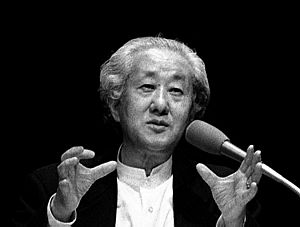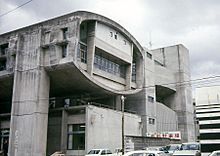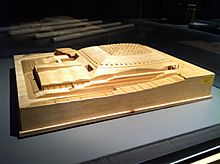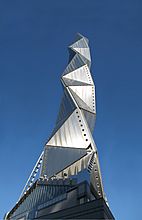Arata Isozaki facts for kids
Quick facts for kids
Arata Isozaki
|
|
|---|---|

Isozaki in 2013
|
|
| Born | 23 July 1931 |
| Died | 28 December 2022 (aged 91) Naha, Okinawa Prefecture, Japan
|
| Nationality | Japanese |
| Alma mater | University of Tokyo (1954 and 1961) |
| Occupation | Architect |
| Spouse(s) | Aiko Miyawaki |
| Awards |
|
| Buildings |
|
Arata Isozaki (磯崎 新, Isozaki Arata; born July 23, 1931 – died December 28, 2022) was a famous Japanese architect. He was also an urban designer, which means he planned how cities should look and grow. He was also a theorist, someone who thinks deeply about ideas. Isozaki was born in Ōita, Japan. He received the Royal Gold Medal in 1986 and the Pritzker Architecture Prize in 2019. These are two of the highest honors an architect can receive. He also taught at well-known universities like Columbia University, Harvard University, and Yale University.
Contents
Who Was Arata Isozaki?
Early Life and Education
Arata Isozaki was born in Ōita, a city on the island of Kyushu in Japan. He grew up during a time when Japan was rebuilding after World War II. In 1945, he saw the city of Hiroshima destroyed from across the shore. This experience deeply affected him. He later said that his first experience with architecture was seeing "the void of architecture." This made him think about how people could rebuild their homes and cities.
Isozaki finished high school in Ōita. He then went to the University of Tokyo, where he studied Architecture and Engineering. He graduated in 1954 and continued his studies, earning a special degree in architecture in 1961. Before starting his own company in 1963, he worked for another famous architect named Kenzo Tange.
Developing His Unique Style
Isozaki's first projects were influenced by European ideas. His early buildings mixed styles like "New Brutalism" and "Metabolist Architecture." These were strong, modern styles that focused on raw materials and flexible designs. Examples include the Oita Medical Hall (1959–1960).
As he continued his work, Isozaki's style kept changing. He designed buildings like the Fujimi Country Club (1973–74) and the Kitakyushu Central Library (1973–74). Later, he created even more modern buildings. These include the Art Tower of Mito (1986–90) and the Domus-Casa del Hombre (1991–1995) in Galicia, Spain.
In 1985, he designed the inside of the Palladium nightclub in New York City. One of his most famous works in the United States is the Museum of Contemporary Art (MOCA) in Los Angeles. It was finished in 1986.
In 2005, Isozaki opened a new office in Italy called Arata Isozaki & Andrea Maffei Associates. From this office, they designed important buildings. These include the Allianz Tower in Milan, Italy, and a new Town Library in Maranello, Italy.
Isozaki was known for not sticking to just one architectural style. He believed that each building should be designed specifically for its location and purpose. He won the prestigious Pritzker Architecture Prize in 2019 for his amazing work.
Arata Isozaki passed away on December 28, 2022, at the age of 91.
Awards and Recognition
Arata Isozaki received many awards throughout his career, recognizing his important contributions to architecture:
- Annual Prize, Architectural Institute of Japan in 1967 and 1975
- Mainichi Art Award in 1983
- RIBA Gold Medal in 1986
- International Award "Architecture in Stone" in 1987
- Arnold W. Brunner Memorial Prize of the American Academy and Institute of Arts and Letters in 1988
- Chicago Architecture Award in 1990
- Honor Award, the American Institute of Architects in 1992
- RIBA Honorary Fellow in 1994
- Golden Lion, 6 Venice Biennale of Architecture in 1996
- The European Cultural Centre (ECC) Architecture Award in 2012
- Pritzker Prize in 2019
Gallery
-
The Art Tower in Mito, Ibaraki (1990).
Notable Works
Here are some of the many important buildings Arata Isozaki designed:
- Ōita Prefectural Library, (1962–1966) in Ōita, Ōita, Japan
- Kitakyushu Municipal Museum of Art (1972–1974) in Fukuoka, Japan
- Kitakyushu Central Library (1973–1974) in Fukuoka, Japan
- Museum of Modern Art, Gunma (1974) in Takasaki, Japan
- Museum of Contemporary Art (MOCA), (1981–1986) in Los Angeles, California, United States
- Sports Hall for the 1992 Summer Olympics, (1983–1990) in Barcelona, Spain
- Ochanomizu Square Building – Casals Hall, (1984–1987) in Tokyo, Japan
- Palladium nightclub building interior (1985) in New York City, United States
- Lake Sagami Country Clubhouse (1987–1989) in Yamanishi, Japan
- Art Tower Mito, Mito, (1986–1990) Ibaraki, Japan
- Team Disney Orlando, (1987–1990) in Florida, United States
- Bond University, – Library, Administration Building, Faculty of Humanities Building (1987–1989) in Gold Coast, Australia
- KitaKyushu International Conference Center (1987–1990) in Fukuoka, Japan
- Palafolls Sports Complex Pavilion, (1987–1996) in Barcelona, Spain
- Centre of Japanese Art and Technology, (1990–1994) in Kraków, Poland
- Nagi Museum Of Contemporary Art, (1991–1994) in Okayama, Japan
- Kyoto Concert Hall, (1991–1995) in Kyoto, Japan
- Nara Centennial Hall, (1992–1998) in Nara, Japan
- Domus: La Casa del Hombre, (1993–1995) in A Coruña, Spain
- Shizuoka Performing Arts Center (SPAC), (1993–1998) in Shizuoka, Japan
- COSI Columbus, (1994–1999) in Columbus, Ohio, United States
- Municipal Daycare and Hospital Complex (1997-1998) in Tokyo, Japan
- Shenzhen Cultural Center, (1998–2007) in Shenzhen, China (includes Shenzhen Library and Shenzhen Concert Hall)
- New entrance of the CaixaForum Barcelona building, (1999–2002) in Barcelona, Spain
- Isozaki Atea, (1999–2009) in Bilbao, Spain
- Torino Palasport Olimpico, (2000–2006) in Turin, Italy
- Museum of the Central Academy of Fine Arts in Beijing, (2003–2008) China
- New Concert Hall Building, (2003–) in Thessaloniki, Greece
- Himalayas Center, (2003–) in Shanghai, China
- Pavilion of Japanese Army in World War II, Jianchuan Museum Cluster, (2004–2015) in Chengdu, China
- Diamond Island, (2006–) in Ho Chi Minh City, Vietnam (completed in 2012)
- Coliseum da Coruña, in A Coruña, Galicia, Spain, 1991
- Weill Cornell Medical College in Qatar, Education City, near Doha
- Qatar National Convention Center, opened 2011
- New Town Library (2012) in Maranello, Italy (with Andrea Maffei)
- D38 Office (2012) in Barcelona, Spain
- Allianz Tower (Il Dritto) (2015), in Milan, Italy (with Andrea Maffei)
- Harbin Concert Hall (2015), in Harbin, China
Other Projects
- The University of Central Asia's three campuses in Tekeli, Kazakhstan; Naryn, the Kyrgyz Republic; and Khorog, Tajikistan
- The New exit for the Uffizi Gallery, Florence, Italy – competition winner (with Andrea Maffei)
- The renovation of the Bologna Centrale railway station, Bologna, Italy – competition winner
- Metropolis Thao Dien, Ho Chi Minh City, Vietnam
See also
 In Spanish: Arata Isozaki para niños
In Spanish: Arata Isozaki para niños






